A kitchen without a cutting board is never complete! Cutting boards are an ever-present friend to every homeowner in the kitchen. However, what happens when they develop mold? Is mold dangerous?
Your wooden cutting board easily absorbs water during washing. Additionally, its porous surface absorbs raw meat, vegetable, and fruit juices into the wood during cutting and dicing.
Eventually, if you do not clean it properly, a fungal growth called mold develops on the surface of your cutting board.
However, cutting boards can also risk your health if you don’t care for them properly. Research says a bacteria called campylobacter causes 1.5 million foodborne diseases in the US. It poses a financial burden of $1.7 billion on the health department. And the primary factor for this contamination is your cutting board.
This article discusses the dangers of mold and how to remove it from your cutting board. We also discuss how to prevent mold formation on your wood-cutting board. Read on to the end.
JUMP TO: Health Hazards of Mold in Cutting Board | How Mold Makes you Sick | How to Remove Mold From Cutting Board | How to Prevent Mold on Cutting Boards |
- It produces mycotoxins that are dangerous to your health
- It causes allergic conditions
- Prolonged mold exposure can lead to death, depression, fatigue, headaches, memory loss, etc.
Coming into direct contact with mold or eating food contaminated with mold poses several health hazards. Some of the dangers include:
Mold on cutting boards – Why it is Dangerous
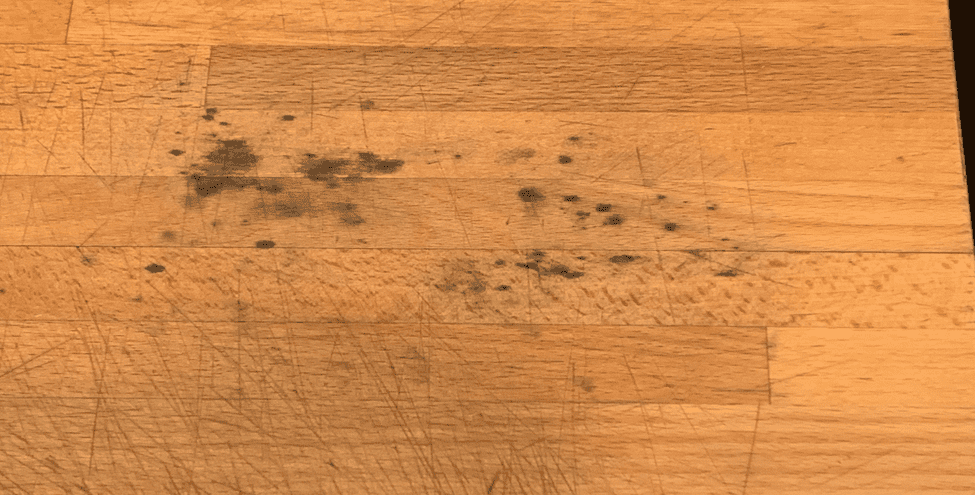
Source: reddit
The more slicing and dicing we do on the wood cutting boards can cause molds. Mold mixed with the food we cook can be a health hazard to you and ruin your cutting board.
Here is why mold on cutting boards is dangerous:
They Produce Mycotoxins
Mycotoxins are toxins produced by molds. According to the National Library on Medicine, if consumed in food, mycotoxins can cause diseases, even death. However, this severity depends on the amount consumed, the individual’s age, and the exposure length.
In severe cases, the mycotoxins in your cutting boards can cause gastrointestinal symptoms such as diarrhea and vomiting.
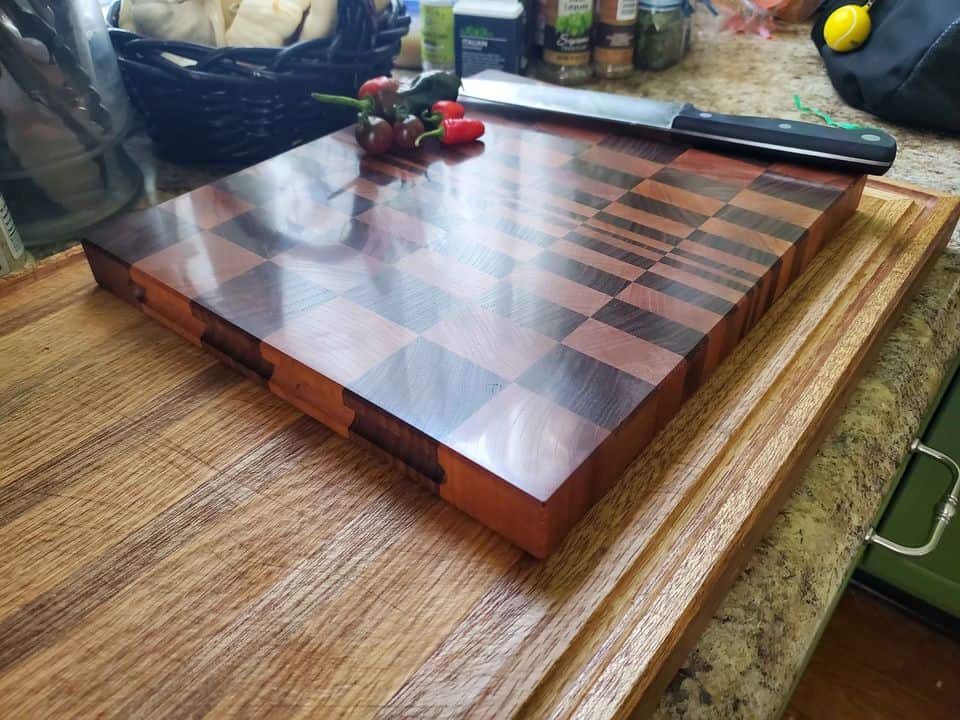
Even a small amount of mold on your wood-cutting board can be dangerous. Ingesting low levels of mycotoxins over a long period can lead to the suppression of the immune system.
Aflatoxin is the most common type of mycotoxin found in mold. Research shows that high ingestion of aflatoxin is fatal.
Related Read: How to Season A Cutting Board?
Mold Causes Allergic Reactions
Using wooden cutting boards that have mold is dangerous for people with allergies. Exposure to mold results in the overreaction of your immune system.
According to research, the reaction is even worse if you have asthma. Mold exposure leads to difficulties in breathing, especially for asthmatic people.
Caution: Persistent shortness of breath could indicate a severe medical issue, kindly see your doctor.
The common symptoms of mold allergy include:
- Runny or stuffy nose
- Dry, scaly skin
- Itchy nose, eyes, and throat
- sneezing
- Coughing
- Watery eyes
Important note: Allergy to mold ranges from mild to severe, and its effects vary from one person to another.
Long-Term Effects of Exposure to Mold
Although short-term mold exposure may not be hazardous, prolonged exposure can lead to serious health issues. Among these include:
Death
Prolonged exposure to mold decreases your lifespan.
Sounds scary, doesn’t it?
Specific black mold is toxigenic, and inhaling or coming into contact with it brings death relatively closer. Aged people, those with low immunity, and children are usually at higher risk.
Depression
A study by ScienceDirect shows that there is a correlation between mold exposure and depression. According to the study, sustained exposure to mold severely affects mental health.
In addition to depression, the study reveals that mold can also cause other symptoms related to poor mental health, such as:
- Word recollection issues
- Confusion
- Anxiety
- Vertigo
- Mood swings
Fatigue
Food becomes infected when you cut or dice it on a mold-infested cutting board. Eating such food forces your body to work extra hard to fight the effects of mold infection.
The extra efforts that your immune system exerts to fight the infection consume much energy, leaving you feeling fatigued. In most cases, however, you may not even understand why you feel exhausted.
This condition might be worse, especially where asthma and other breathing difficulties are involved.
Headaches
An American College of Allergy, Asthma, and Immunology study shows that mold can cause headaches. According to the study, prolonged mold exposure has always been a cause of sinus headaches among many people.
Memory Loss
According to research, being in contact with mold or inhaling mold for a long affects your brain. Consequently, this leads to effects on the brain, especially short-term memory.
In addition, prolonged mold exposure can cause issues with judgment, concentration, and overall brain function.
However, the good news is that any memory loss caused by mold is reversible. All you need is to get rid of all mold around you and keep away from direct contact.
Lung Problems
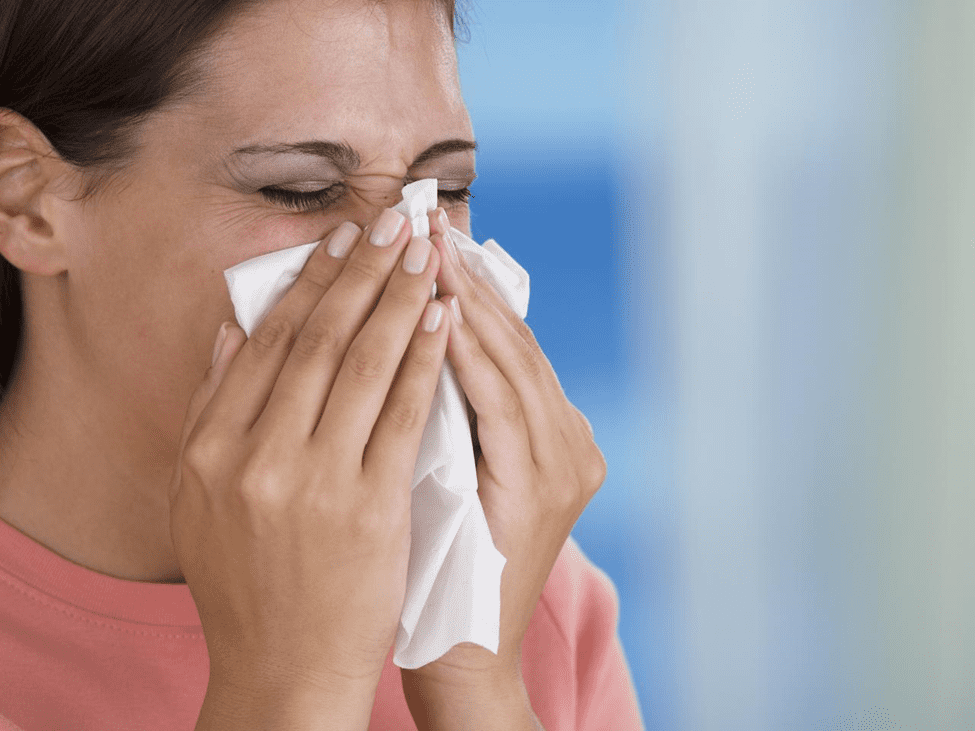
source: HGTV
Prolonged mold exposure can severely affect your lungs and the respiratory system. Studies show that 70 percent of homes in the United States battle mold problems. Consequently, lung problems are a common issue in many homes.
Also Read: Acacia Vs. Teak Cutting Board – Here’s What To Buy!
How Quickly Can Mold Make Me Sick?
The effects of exposure to the mold on your cutting board may vary from one person to the other. The results are immediate to some people, while the effects are delayed to others. In fact, some people may not develop any symptoms at all.
The following factors determine how long it will take you to feel the effects.
- Allergies and sensitivities: People that are allergic to mold might experience the effects immediately
- Amount of mold: Exposure to a large amount of mold is more likely to cause health effects than exposure to small amounts.
- Duration of exposure: The longer you get exposed to mold, the higher the chances of getting affected.
- Proximity to mold: When cleaning your wood cutting boards, if you directly handle the mold, this raises the chances of you being affected.
How to Remove Mold from Cutting Boards
If your wood or plastic cutting boards have mold, don’t throw them away. Here are three simple and effective methods of removing mold.
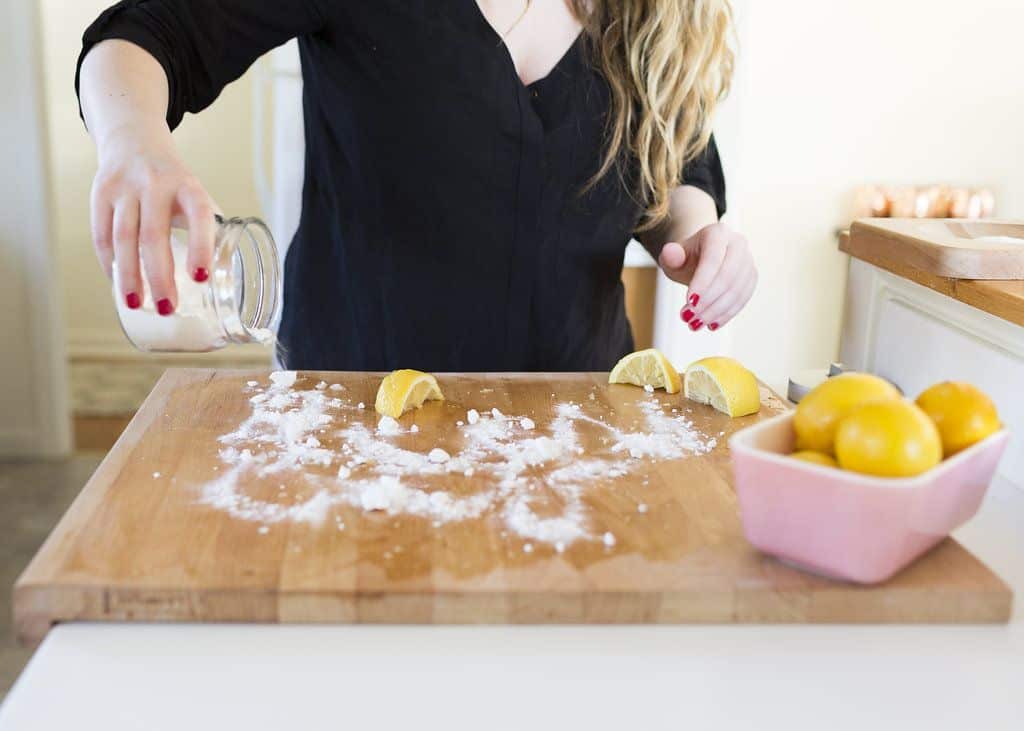
Source: thepioneerwoman.com
Use Salt and Lemon
For home enthusiasts who prefer natural mold removal methods for wood or plastic cutting boards, salt and fresh lemon are the go-to natural cleansers.
- Sprinkle coarse salt over the board in large measures
- Slice a fresh lemon juice in half
- Rub the lemon juice wedge over the cutting board in a circular motion while squeezing it lightly to release the juice
- Allow the mixture to rest for five minutes
- Scrape it and discard
- Rinse the board under warm running water.
- If any stubborn lemon juice or salt is left on the cutting board, use a scouring sponge and dish soap to wash it away.
- Put the board in your kitchen drying rack and allow it to air dry before putting it away.
The salt provides an abrasive property to penetrate the cracks and grooves of the cutting board surface, removing any mold, stains, and bacteria.
Besides cleaning, this method helps to remove odor, leaving your cutting board smelling fresh.
Use Bleach
Bleach is an excellent disinfectant and mold killer. However, although it’s safe for kitchen items, use it sparingly.
The USDA Food Safety and Inspection Service recommends diluting bleach for cleaning and sanitizing cutting boards.
- Mix one tablespoon of liquid chlorine bleach (unscented) with a gallon of water
- Pour the solution on one side of the cutting board. Let it stand for some minutes.
- Flip the board and pour the solution on the second side
- Rinse the board thoroughly under running water
- Pat it dry with paper towels
- Give it time to dry in the air, then put it away
Use Vinegar
Another effective method to clean and deodorize a moldy cutting board is using white vinegar.
- Soak a clean dishcloth in a 1:1 ratio of water and white vinegar
- Wring the cloth slightly, then place it over the cutting board. Ensure that it covers the moldy part.
- Let it sit for five minutes
- Scrub the board gently with the cloth
- Rinse with clean water and pat dry
- Leave it to air dry
How to Prevent Mold On Cutting Boards
The primary cause of mold on the chopping board is knife marks. While knife marks are unavoidable, you can prevent mold growth on your board if you follow the techniques below:
Proper Washing
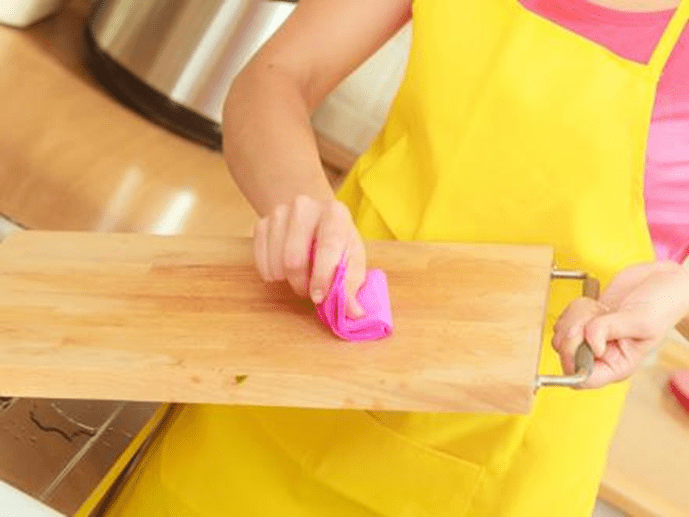
Source: Food Network
Any cutting board that is not appropriately cleaned is likely to grow mold and other bacteria.
The advice here is to wash your board with dish soap and warm water after every use.
And if you were cutting seafood or raw meat, it would be good to use bleach, white vinegar, or a natural cleanser to disinfect and eliminate all bacteria.
You can wash plastic and glass cutting boards in a dishwasher, but never wash wooden boards in this appliance.
Wooden cutting boards are porous; that’s why it is advisable to wash them by hand. Then, dry them with an absorbent kitchen cloth or paper towel and leave them to air dry before putting them away.
Tip: When drying a wooden board, place it upright in a dish drainer so that air can reach all sides.
Never Soak Your Cutting Board
Leaving your wooden cutting board to soak in the sink can cause great harm.
A soaked board is likely to swell, warp and crack with time. Any slight crack will become a good breeding ground for mold.
Interesting Read: Can You Stain Cutting Boards?
Keep Your Board Oiled
Oiling your wooden cutting board keeps it cleaner and mold-free and prevents it from dry-out.
At least once every month, soak a clean cloth in food-grade mineral oil and rub it into the cutting board. Let the food-grade mineral oil soak into the wood grains for five to six hours, then wipe off the excess with a clean towel.
![Wood Cutting Board Vs. Plastic Board [Which is Safer?] Wood Cutting Board Vs. Plastic Board [Which is Safer?]](https://houseadorable.com/wp-content/uploads/2023/01/wood-board.jpg)
![27 Types of Cutting Boards Explained [Buying Guide Included] 27 Types of Cutting Boards Explained [Buying Guide Included]](https://houseadorable.com/wp-content/uploads/2022/12/cutting-board.jpg)
![Bamboo Vs. Wood Cutting Board [9 Differences Explained] Bamboo Vs. Wood Cutting Board [9 Differences Explained]](https://houseadorable.com/wp-content/uploads/2023/01/cutting-board.jpg)
![How to Disinfect Wood Cutting Board? [5 Methods] How to Disinfect Wood Cutting Board? [5 Methods]](https://houseadorable.com/wp-content/uploads/2023/01/1466451602030.jpeg)
![Is Bamboo Wood Good for Cutting Boards?[8 Reasons Explained] Is Bamboo Wood Good for Cutting Boards?[8 Reasons Explained]](https://houseadorable.com/wp-content/uploads/2023/01/316002766_5887666997938019_9068589372518329358_n.jpg)
![Charcuterie Board Vs. Cutting Board [8 Differences] Charcuterie Board Vs. Cutting Board [8 Differences]](https://houseadorable.com/wp-content/uploads/2023/01/316322082_5650827684977137_862859335334204275_n.jpg)
![Can You Put A Wooden Cutting Board In The Oven? [Answered] Can You Put A Wooden Cutting Board In The Oven? [Answered]](https://houseadorable.com/wp-content/uploads/2023/01/clean-wooden-cutting-board-4772583_01-2aba9de81be84c55a8e1dbb63822b806-scaled.jpg)
![Is Acacia Wood Good For Cutting Boards? [Explained] Is Acacia Wood Good For Cutting Boards? [Explained]](https://houseadorable.com/wp-content/uploads/2023/01/wood-table-top-with-acacia-chopping-board-with-blur-kitchen-counter-background-is.jpg)